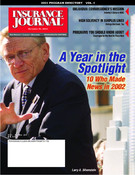Oklahoma Insurance Commis-sioner Carroll Fisher put it best when he recently said, “The best regulator of insurance rates is the consumer. For all the hard work state employees do to regulate insurance companies, nothing is as effective at keeping down rates as the threat that a consumer may move to another company.”
Texas needs to reform the homeowners insurance market, but not for the reasons heard during the recent political season.
There are reasons for high homeowners rates: weather, excessive lawsuits and rising claim costs.
We can’t change Texas weather. We will always have wind, hail, tornadoes, hurricanes and tropical storms. But excessive court settlements for risks never contemplated in product pricing are another matter.
We all pay more for our insurance because of litigation and insurance fraud. That’s why efforts to stiffen the penalties for filing frivolous lawsuits and to establish standards for mold remediation are so important.
For years, Texas homeowners were required to buy a single policy with the broadest coverage in the country. This state-mandated insurance policy forced high prices for all consumers.
Some politicians have called for more regulation of insurance rates, believing this will result in lower premiums. That position does not solve the fundamental problem of rising claim costs. Arbitrarily setting prices below claim costs and forcing insurers out of business will not protect Texas homeowners.
The worst insurance market in the country, New Jersey, provides a chilling illustration of what can happen when over-zealous regulation and stifled competition takes place.
During the last decade, 20 auto insurers have left New Jersey, refusing to do business there primarily because of the oppressive regulatory system which has a stranglehold on competition.
When compared to the rest of the country, New Jersey drivers usually pay the highest rates, have many fewer choices and have virtually no competitive pricing for auto insurance.
Four out of the six auto largest insurance companies in the country do not write business in New Jersey. Twenty auto insurers have left New Jersey in the past 10 years.
Texas insurers have reported extraordinary homeowners insurance losses from water claims, which have increased fivefold over the past 18 months. Despite the fact that Texas has the highest homeowners rates, insurers here have sustained over $3.1 billion in losses between 1988 and 2000.
To be certain that insurers can deliver on their promise to pay covered claims that arise in the future, they must charge premiums today that are adequate.
A recent Southern Methodist University study on the Texas insurance problems noted that increased regulation and price “fixing” will worsen the situation. Consumers benefit, the report said, when insurers have the opportunity to compete on rates and policy language as to “what is covered.” Evidence from other states, such as Illinois and South Carolina, suggest that market modernization is the best medicine.
The South Carolina General Assembly passed an auto insurance reform measure in 1997 with some dramatic results. After years of ranking in the middle of the pack, when comparing average auto insurance expenses in the country, South Carolina ranked 38th among the 50 states in the nation for auto insurance in 1999.
The new law encouraged more competition in the auto insurance market by decreasing restrictions on what products insurers could offer consumers and by allowing them to price those products appropriately. According to the South Carolina Department of Insurance, the number of auto insurers writing business in that state increased significantly between 1996 and 2000. During 1996, only 74 insurers were doing business in South Carolina. That number grew to 156 in 2000. (This represents an increase of 111 percent in the number of companies offering auto insurance in the state).
In South Carolina, rates are competitive, there is a cooperative spirit with the regulators and companies are able to sustain a profit. Therefore, companies are clamoring to enter the state, not exit the state.
The Texas Coalition for Affordable Insurance Solutions (www.tcais.org), supported by the states’ major insurers, is promoting a plan for a stable regulatory environment. This approach will encourage companies
to compete for business and offer Texans a wide choice of coverage at the best possible rates.
Solving Texas’ insurance problems is within reach. Let’s offer consumers more flexibility in coverage, not less. Free-market competition is, and will remain, the best way to increase availability and produce the lowest prices.
Sandra Ray is public affairs director for Southwestern Insurance Information Service, a 50 year-old insurance trade association representing companies that write 85 percent of the property and casualty premiums in Texas.
Topics Trends Carriers Texas Auto Legislation New Jersey Homeowners Market South Carolina
Was this article valuable?
Here are more articles you may enjoy.


 Progressive Q2 Net Income Skyrockets Over 320%
Progressive Q2 Net Income Skyrockets Over 320%  Global Tech Outage Disrupts Industries, Highlights Online Risks
Global Tech Outage Disrupts Industries, Highlights Online Risks  Travelers Reverses Q2 Income Loss, Narrows Underwriting Loss
Travelers Reverses Q2 Income Loss, Narrows Underwriting Loss  Soccer Officials Arrested After Melee That Damaged Hard Rock Stadium in Miami
Soccer Officials Arrested After Melee That Damaged Hard Rock Stadium in Miami 


